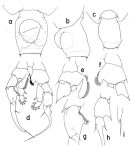|
|
 |
|
Calanoida ( Order ) |
|
|
|
Arietelloidea ( Superfamily ) |
|
|
|
Heterorhabdidae ( Family ) |
|
|
|
Heterorhabdus ( Genus ) |
|
|
| |
Heterorhabdus prolixus Park, 2000 (F,M) | |
| | | | | | | Ref.: | | | Park, 2000 (p.120, figs.F,M, Rem.) |  issued from : T. Park in Bull. Scripps Inst. Oceanogr. Univ. California, San Diego, 2000, 31. [p.238, Fig.86]. Female: a, habitus (left side); b, urosome (dorsal); c, d, forehead (left, dorsal, respectively); e, f, genital somite (left, right, respectively); g, h, genital somite with operculum open (left, right, respectively). gfl = genital flange. Nota: Length ratios of 4 urosomal somites and left caudal ramus 37.8 : 17.7 : 15.2 : 8.6 : 20.7 = 100. Dorsal appendicular seta of left caudal ramus twice as long as that of right ramus. Anteriorly, caudal rami each with 2 pores.
|
 issued from : T. Park in Bull. Scripps Inst. Oceanogr. Univ. California, San Diego, 2000, 31. [p.239, Fig.87]. Female: a, genital somite (ventral); b, c, abnormal genital somite (left, dorsal, respectively). Nota: Genital field with 7-9 pores on each side. Male: d, P5 (anterior); e, basipod of right P5 (anterior); f, basipod of left P5 (anterior); g, second exopodal segment of right P5 (anterior); h, exopod of left P5 (anterior); i, distal end of exopod of right P5 (lateral).
|
 Heterorhabdus prolixus Heterorhabdus prolixus female: 1 - See key to species groups of Heterorhabdus: ''abyssalis'' Group (p.90, 114). 2 - Genital somite without a conical projection mediodorsally (Fig.86- a, d). 3 - Laterally, genital somite without a tubercular outgrowth posteriorly on dorsal margin (Fig.86-d). 4 - Laterally, genital operculum far short of reaching posterior end of somite (Fig.86-d). 5 - Laterally, right and left genital flanges asymmetrical (Fig.86-e, f). 6 - Laterally, left genital flange low, smoothly arched. 7 - Laterally, genital somite relatively elongate, typically with a length-depth ratio of 100:83 (Fig.86-e).
|
 Heterorhabdus prolixus Heterorhabdus prolixus male: 1 - See key to species groups of Heterorhabdus: ''abyssalis'' Group (p.90, 114). 2 - Basal inner lobe of left P5 short, finger-like. 3 - Basal inner lobe of left P5 distally rounded (Fig.87-f).
| | | | | Compl. Ref.: | | | Park & Ferrari, 2009 (p.143, Table 8, biogeography) | | | | NZ: | 4 | | |
|
Distribution map of Heterorhabdus prolixus by geographical zones
|
| | | | Loc: | | | E Pacif. equatorial, W America (39° S - 27° N), off N Chile
Type locality: 31°47'S, 75°03'W.
For Park (2000, p.121), the species, apparently, is endemic to the coastal waters of the east Pacific but may be carried westward to some distance in the equatorial currents. | | | | N: | 1 | | | | Lg.: | | | (824) F: 2,92-2,36; M: 2,88-2,28; {F: 2,36-2,92; M: 2,28-2,88} | | | | Rem.: | "Abyssalis" Group.
Park (2000, p.121) observes an abnormality exclusively in the shape of the genital somite. See remarks for H. spinosus from Bradford (1971a, p.124).
For Park (2000, p.123) H. prolixus, H. clausi, H. tuberculus are morphologically very close to one another and can be distinguished from one another by carefully comparing the shape of the female genital somite and the male P5. | | | Last update : 20/05/2017 | |
|
|
 Any use of this site for a publication will be mentioned with the following reference : Any use of this site for a publication will be mentioned with the following reference :
Razouls C., Desreumaux N., Kouwenberg J. and de Bovée F., 2005-2025. - Biodiversity of Marine Planktonic Copepods (morphology, geographical distribution and biological data). Sorbonne University, CNRS. Available at http://copepodes.obs-banyuls.fr/en [Accessed December 30, 2025] © copyright 2005-2025 Sorbonne University, CNRS
|
|
 |
 |





